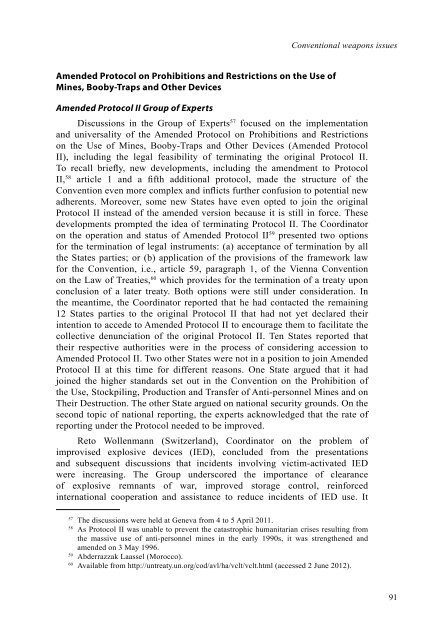DYB2011-Part-II-web
DYB2011-Part-II-web
DYB2011-Part-II-web
Create successful ePaper yourself
Turn your PDF publications into a flip-book with our unique Google optimized e-Paper software.
Amended Protocol on Prohibitions and Restrictions on the Use of<br />
Mines, Booby-Traps and Other Devices<br />
Conventional weapons issues<br />
Amended Protocol <strong>II</strong> Group of Experts<br />
Discussions in the Group of Experts57 focused on the implementation<br />
and universality of the Amended Protocol on Prohibitions and Restrictions<br />
on the Use of Mines, Booby-Traps and Other Devices (Amended Protocol<br />
<strong>II</strong>), including the legal feasibility of terminating the original Protocol <strong>II</strong>.<br />
To recall briefly, new developments, including the amendment to Protocol<br />
<strong>II</strong>, 58 article 1 and a fifth additional protocol, made the structure of the<br />
Convention even more complex and inflicts further confusion to potential new<br />
adherents. Moreover, some new States have even opted to join the original<br />
Protocol <strong>II</strong> instead of the amended version because it is still in force. These<br />
developments prompted the idea of terminating Protocol <strong>II</strong>. The Coordinator<br />
on the operation and status of Amended Protocol <strong>II</strong>59 presented two options<br />
for the termination of legal instruments: (a) acceptance of termination by all<br />
the States parties; or (b) application of the provisions of the framework law<br />
for the Convention, i.e., article 59, paragraph 1, of the Vienna Convention<br />
on the Law of Treaties, 60 which provides for the termination of a treaty upon<br />
conclusion of a later treaty. Both options were still under consideration. In<br />
the meantime, the Coordinator reported that he had contacted the remaining<br />
12 States parties to the original Protocol <strong>II</strong> that had not yet declared their<br />
intention to accede to Amended Protocol <strong>II</strong> to encourage them to facilitate the<br />
collective denunciation of the original Protocol <strong>II</strong>. Ten States reported that<br />
their respective authorities were in the process of considering accession to<br />
Amended Protocol <strong>II</strong>. Two other States were not in a position to join Amended<br />
Protocol <strong>II</strong> at this time for different reasons. One State argued that it had<br />
joined the higher standards set out in the Convention on the Prohibition of<br />
the Use, Stockpiling, Production and Transfer of Anti-personnel Mines and on<br />
Their Destruction. The other State argued on national security grounds. On the<br />
second topic of national reporting, the experts acknowledged that the rate of<br />
reporting under the Protocol needed to be improved.<br />
Reto Wollenmann (Switzerland), Coordinator on the problem of<br />
improvised explosive devices (IED), concluded from the presentations<br />
and subsequent discussions that incidents involving victim-activated IED<br />
were increasing. The Group underscored the importance of clearance<br />
of explosive remnants of war, improved storage control, reinforced<br />
international cooperation and assistance to reduce incidents of IED use. It<br />
57 The discussions were held at Geneva from 4 to 5 April 2011.<br />
58 As Protocol <strong>II</strong> was unable to prevent the catastrophic humanitarian crises resulting from<br />
the massive use of anti-personnel mines in the early 1990s, it was strengthened and<br />
amended on 3 May 1996.<br />
59 Abderrazzak Laassel (Morocco).<br />
60 Available from http://untreaty.un.org/cod/avl/ha/vclt/vclt.html (accessed 2 June 2012).<br />
91


